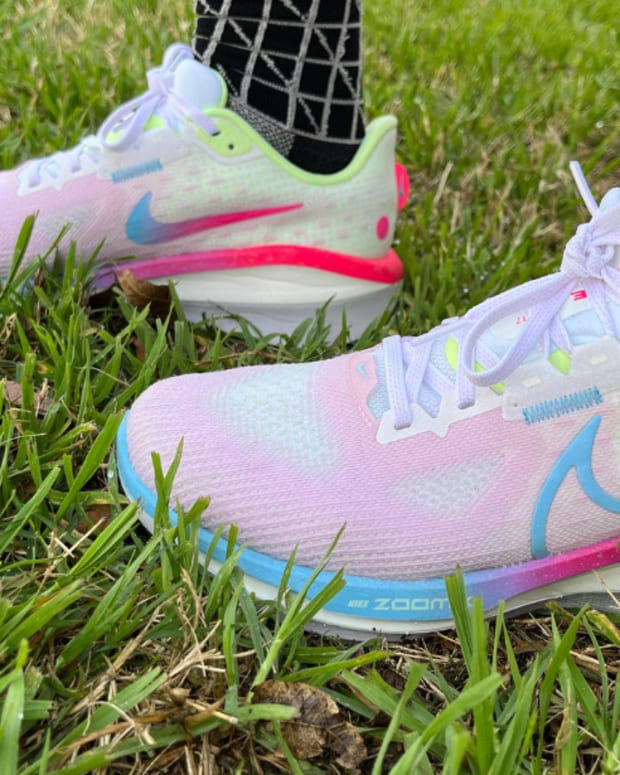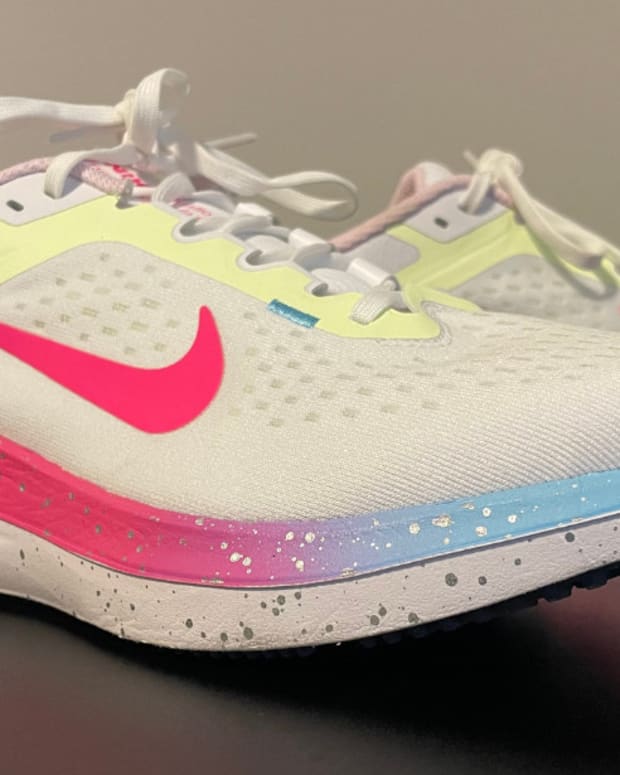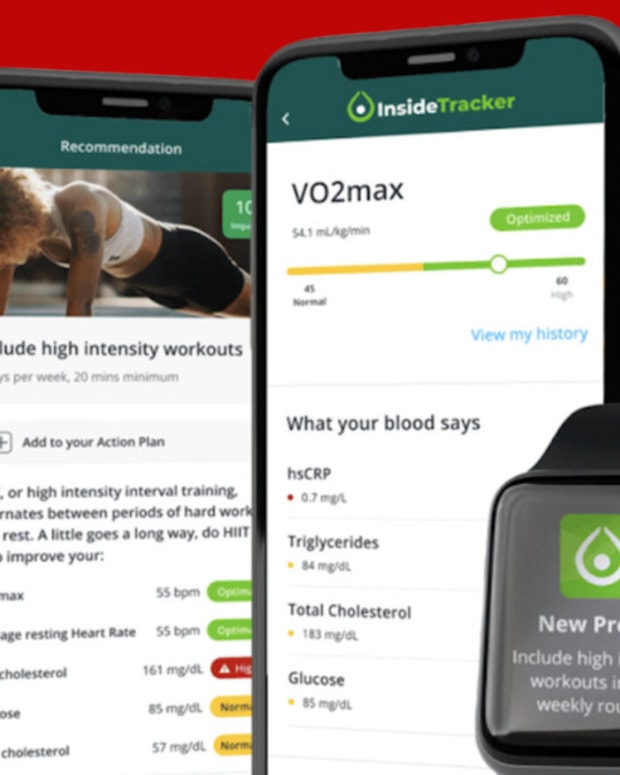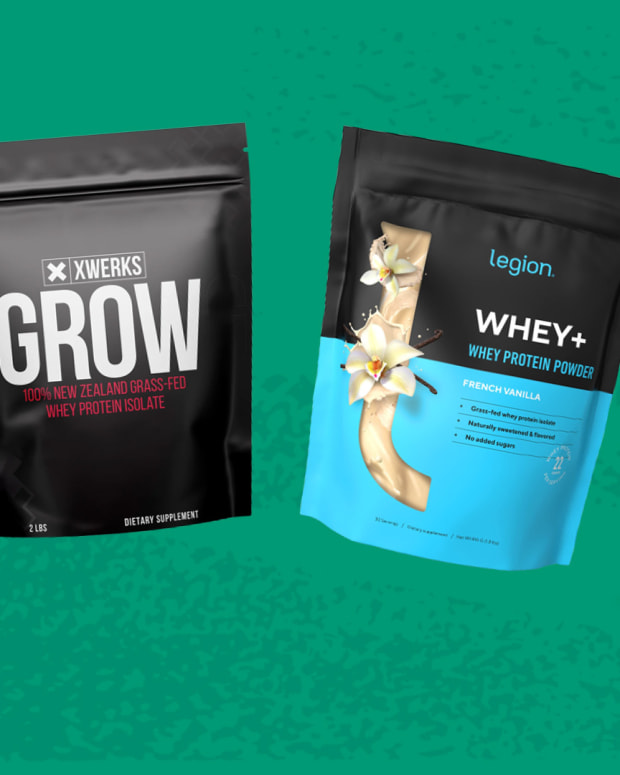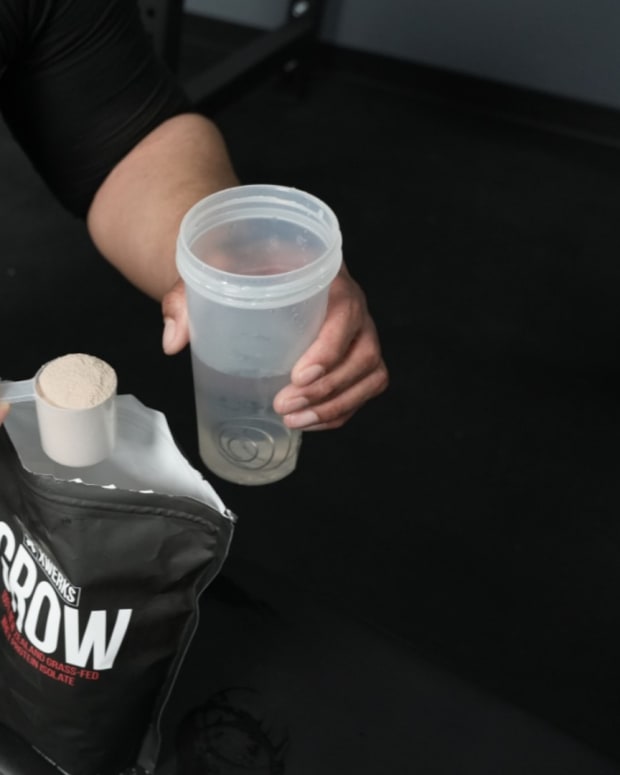The products featured in this article have been independently reviewed. When you buy something through the retail links on this page, we may earn commission at no cost to you, the reader. Sports Illustrated editorial staff are not involved in the creation of this content. Learn more here.
Creatine supplements are one of the most popular sports nutrition supplements. But if you’ve ever taken creatine in powder form, you know that it can be chalky, gritty and just downright hard to get down. Enter gummy vitamins.
Creatine gummies contain effective doses of creatine, wrapped up in a delicious package of sweeteners and flavorings, like fruit punch or strawberry. And they don’t just taste better, they’re easier to take, too, since you don’t have to mix them with water.
But gummies typically have longer ingredient lists and many of them are subpar, in flavor and quality. To help you find the best creatine gummies, we talked to two nutrition experts and dug into the research on creatine. We also considered important factors, like dosage, ingredients, flavors and price. These are our top picks.
This content is meant to be informative, but should not be taken as medical advice. It is not intended for use as diagnosis, prevention or treatment of health problems. Always speak with your doctor before starting any new supplement or exercise regimen.
Our Picks for the Best Creatine Gummies:
- Best Overall Creatine Gummies: Bear Balanced Creatine Gummies
- Best Low-Sugar Creatine Gummies: SWOLY Creatine Gummies
- Best Creatine Gummies for Muscle Building: Animal Creatine Chews
- Best Vegan Creatine Gummies: Bizi Creatine Gummies
- Best Tasting Creatine Gummies: Create Creatine Gummies
Best Overall Creatine Gummies: Bear Balanced Creatine Gummy
Key features and specs:
- Creatine per serving: 3 grams
- Nutrition facts: 15 calories, 0 grams protein, 8 grams carbohydrates, 0 grams sugar
- Flavors: Blueberry
- Certifications: Dairy-free, gluten-free, nut-free, GMP-certified, ISF/GFSI-certified
- Subscription: Monthly, two months, three months; 10-15% off
- Key ingredients: Creatine monohydrate, L-theanine, L-tyrosine, vitamin B12
- Sweeteners: Stevia, inulin syrup
- Best for: Those on keto or low-carb diets; people who want some B12 too
- Price per serving: $1.50
Why I picked it:
Want to get all the benefits of creatine without the mess of mixing a powder? Check out Bear Balanced Creatine Gummies. Bear Balanced only makes creatine gummies, and is very intentional about its ingredients. That’s why we rank them as our pick for the best overall creatine gummies. The gummies are blueberry flavored and sweetened with stevia extract and sugar alcohols instead of sugar. They also contain inulin syrup, which is a prebiotic, fiber-based sweetener that has no net carbs.
The nutrition facts label lists eight grams of total carbohydrates, but five grams come from fiber, and three grams come from sugar alcohols, bringing the net carbs down to zero. This makes these creatine gummies suitable for those on keto and low-carb diets.
The gummies contain three grams of creatine monohydrate per serving and supportive ingredients like L-theanine, L-tyrosine and vitamin B12. Thanks to these additional ingredients, some customers say they use Bear Balanced Creatine Gummies as a supplement to support energy production in the body. Reviewers also say these gummies taste great and don’t cause any digestive upset.
Related Post: Creatine vs. Pre-Workout: Which One Should You Take?
What we love:
- No sugar
- Additional supportive ingredients
- Contains fiber
What to consider:
- Contains sugar alcohols
- High price per serving
Best Low-Sugar Creatine Gummies: SWOLY Creatine Gummies
Key features and specs:
- Creatine per serving: 4 grams
- Nutrition facts: 15 calories, 0 grams protein, 4 grams carbohydrates, 2.5 grams sugar
- Flavors: Strawberry
- Certifications: Low-sugar, gluten-free, gelatin-free
- Subscription: N/A
- Key ingredients: Creatine monohydrate, maltodextrin, natural and artificial flavors
- Sweeteners: Sucrose (sugar), dextrose
- Best for: Anyone who wants a higher dose of creatine; those who like strawberry flavor
- Price per serving: $1.23
Why I picked it:
It’s difficult to find high-quality gummies that are low in sugar, but SWOLY gets the job done. These gummies are our pick for the best low-sugar creatine gummies because each serving contains just 2.5 grams of sugar. These gummies are not made with any artificial sweeteners, which is another plus for the brand. They’re also gluten-free and gelatin-free, which makes them suitable for vegans.
SWOLY Creatine Gummies are made with creatine monohydrate—the most effective type of creatine—and contain four grams per serving, which is within the effective dosage range (1). Since a serving is five gummies, you can adjust the dosage based on your specific needs. For example, if you want 2.5 grams of creatine, you can take three gummies instead of the recommended five.
The gummies only come in one flavor—strawberry—but our tester, certified personal trainer Kate Meier, called them absolutely delicious. “These gummies are so good, they are almost addicting. They taste just like my favorite fruit snacks,” said Meier.
What we love:
- Made without gelatin
- Gluten-free
- Can adjust dosage
What to consider:
- Contain artificial flavors
- Only one flavor
Best Creatine Gummies for Muscle Building: Animal Creatine Chews
Key features and specs:
- Creatine per serving: 5 grams
- Nutrition facts: 16 calories, 0 grams protein, 4 grams carbohydrates, 4 grams sugar
- Flavors: Fruit Punch, Green Apple, Grape
- Certifications: UL Certified, GMP-certified
- Subscription: 4 or 6 weeks; 10% savings
- Key ingredients: Creatine monohydrate, AstraGin (Panax ginseng and astragalus), sea salt
- Sweeteners: Sucrose, dextrose
- Best for: Those trying to build muscle; anyone who prefers a chew over a gummy
- Price per serving: $1.08
Why I picked it:
Animal is a sports nutrition company that manufactures all of its products in the U.S. in GMP-certified facilities. Like most of the brand’s supplement line, the Creatine Chews are designed for those who want to build muscle and improve overall athletic performance.
These gummies earned the spot of best for muscle building because they’re higher dosage than many of the others on the list. They contain five grams of creatine monohydrate per four gummies, and a patented ingredient called AstraGin, which is a blend of Panax ginseng and astragalus—two adaptogens that Animal says can enhance absorption of the creatine(2). They also have 25 milligrams of sea salt, which can help with water balance and hydration.
These are chewable tablets not true gummies, but they’re still easy to take and come in three flavors: fruit punch, green apple and grape. Customer reviews are largely positive, but some do say the texture is more like chewing an antacid than eating a gummy bear. Most say the taste is still good though, and that they’re experiencing positive results.
What we love:
- High dosage
- Subscribe and save available
- Supportive ingredients that help with absorption
What to consider:
- Texture can be chalky
- Contains artificial flavors
Best Vegan Creatine Gummies: Bizi Creatine Gummies
Key features and specs:
- Creatine per serving: 1 gram
- Nutrition facts: 30 calories, 0 grams protein, 6 grams carbohydrates, 4 grams sugar
- Flavors: Blue Raspberry
- Certifications: Gluten-free, vegan-friendly
- Subscription: N/A
- Key ingredients: Creatine monohydrate, natural colors and flavors
- Sweeteners: Sugar, corn syrup
- Best for: Those who want a lower dose; vegans and vegetarians
- Price per serving: $1.00
Why I picked it:
Bizi is a vegan supplement company that prioritizes high-quality ingredients above all else. Because they’re not made with gelatin, the Bizi Creatine Gummies are suitable for vegans. They’re also gluten-free, low in added sugar and made in the U.S.
It’s worth mentioning that these creatine gummies contain a lower dose per serving than others. There’s one gram of creatine in every two gummies. You could up the amount you take for a higher dose, but each bottle contains only 60 gummies, so you’d run out pretty quickly. Because of that, these gummies are best for lighter-weight athletes who need smaller amounts of creatine, or used in conjunction with other types of creatine.
They come in only one flavor—blue raspberry—and some customers say they have a slight tartness to them that’s reminiscent of Sour Patch Kids, which is a perk for those who don’t like things too sweet. Reviewers also say they’re seeing positive results from taking them.
What we love:
- Made in the U.S.
- Low added sugar
- Slight tartness that cuts the sweetness
What to consider:
- Contains corn syrup
- Low dosage of creatine
Best Tasting Creatine Gummies: Create Creatine Gummies
Key features and specs:
- Creatine per serving: 5 grams
- Nutrition facts: 50 calories, 0 grams protein, 12 grams carbohydrates, 5 grams sugar, etc.
- Flavors: Orange
- Certifications: Non-GMO, vegan, gluten-free
- Subscription: Monthly; 14 to 22% off
- Key ingredients: Creatine monohydrate, pectin, natural colors and flavoring
- Sweeteners: Tapioca syrup, sugar, allulose
- Best for: Vegans and those avoiding gluten; endurance athletes or those who want more carbohydrates
- Price per serving: $2.33
Why I picked it:
Create sells only creatine, and the company’s goal is to get more athletes to experience the benefits of this muscle-building supplement. There’s only one option available: an orange-flavored gummy that contains five grams of creatine monohydrate per serving (five gummies). The gummies are made without gelatin, so they’re vegan-friendly, and they’re also non-GMO and gluten-free.
While they’re partly sweetened with allulose, a low-carb sweetener, they also contain cane sugar and tapioca syrup, so they’re higher in carbohydrates and sugar than other forms of gummies. Because of this, they may not be a great fit for those on a low-carb or keto diet, but could supply a source of energy for endurance athletes.
Our tester, Kate M., enjoyed these creatine gummies mostly for their flavor and gummy form. "These taste like orange fruit snacks. They're really enjoyable to eat, and I'm much more likely to use these than a creatine powder," she said.
Most reviewers on Amazon say they enjoy the flavor, but do not like how easily the gummies melt in warm environments. If you order these gummies online and live in a warm climate, make sure to track your package so they don't sit outside for long. If they do melt, stick them in the fridge to cool down (though you may still need to pull apart gummies that have melted together).
What we love:
- High dose per serving
- Monthly subscription with a 22% discount
- Only natural flavors and colors
- Easy to eat gummy form
- Vegan-friendly and gluten-free
What to consider:
- Higher in sugar
- Only 15 servings per bag
- Gummies melt easily in warm environments
What Is Creatine?
Creatine is a nitrogen-containing amino acid derivative that’s made from the amino acids glycine, arginine and methionine (3). It’s found mostly in your muscles, and it’s one of the most well-researched and popular supplements among weight lifters and athletes since the 1990s, according to Alex Larson, MS, RD, LD, a registered dietitian who works with endurance athletes.
About 95 percent of your body’s creatine is concentrated in your fast-twitch skeletal muscles (4), which are the muscles you rely on for short-term, high-intensity activities (5). Fast-twitch muscles produce a lot of power in a short amount of time but get fatigued quickly (6). “Specifically, the body uses creatine for quick muscular power, so it’s beneficial for endurance sports, like running or cycling,” says Natalie Rizzo, MS, RD, author of Planted Performance and founder of Greenletes.
The other five percent of the creatine in your body is found in the brain and testes. Creatine is used to create adenosine triphosphate (ATP), the main source of energy for muscle contractions (7).
You can get creatine in three ways: Your body can make it; you can get it from your diet (meat and fish [8]); or you can take creatine supplements. Because you naturally lose about two grams of creatine per day, and likely more if you’re an athlete or very active, taking a daily dose of creatine can help replenish your stores and provide various benefits.
Benefits of Creatine Gummies
Just like creatine powder, high-quality creatine gummies provide an effective dose of creatine that may increase muscle mass and improve athletic performance. But there are perks to creatine gummies outside of the general creatine benefits too. They’re convenient and allow you to up your creatine intake in a tasty way.
Increased muscle mass
Many people take creatine to increase strength and build muscle. “The biggest benefit of using creatine is the improvements in strength and power output during resistance-based exercises, and it can modestly increase lean muscle mass. Creatine works mainly by accelerating energy metabolism, allowing muscles to quickly replenish their energy stores and improve strength-based performance,” Larson says.
In studies comparing creatine to a placebo, creatine was shown to have a positive effect on both muscle growth and strength (9). Of course, you still have to incorporate resistance training; creatine can just take your results to the next level.
One meta-analysis compared resistance training alone to resistance training with creatine supplementation (10). The researchers found that creatine could elicit an 8 percent increase in muscle strength and a 14 percent increase in weightlifting compared to resistance training alone.
Improved athletic performance
There are health benefits beyond increased muscle mass. Supplementation increases the availability of creatine in the muscles, which can increase energy and lead to general improvements in exercise performance. In other words, you may be able to delay fatigue and have a more effective workout.
This is especially true with high-intensity exercises. During high-intensity activity, which includes an anaerobic component (11), the body relies on ATP even more. In fact, ATP demand can increase as much as 1,000 times (12).
Creatine has also been shown to enhance muscle recovery and reduce the risk of sports-related injuries, which are both connected to improved athletic performance (13).
Better cognitive function
The brain requires ATP for optimal function. When brain activity is heightened, serum levels of creatine drop to help maintain ATP levels during this increased demand (14). Because of this, “interventions that sustain ATP,” one of which is creatine supplementation, are recommended to help neuron health in the brain.
While more studies are needed to make definitive statements about creatine’s effect on brain health, current research suggests that supplementation can improve cognitive function and daily activities in older adults (15). There’s also some preliminary research that creatine may reduce symptoms of concussion, mild traumatic brain injury and depression (16). However, more research will be needed.
They’re convenient
One of the major downsides of creatine monohydrate is that it’s not very water-soluble. Because of that, it doesn’t mix easily into water, you need about two cups of water to dissolve three grams of powder (17)—the minimum recommended dose (18).
Creatine gummies are less of a hassle. You don’t have to worry about mixing anything with water, since they’re chewable you can eat them like candy. “Creatine gummies are packaged with flavors and a touch of sugar to make them taste good and they are easy to eat quickly,” says Rizzo.
The gummies are also more convenient to take with you on-the-go. Instead of worrying about bringing a jar of powder and a shaker bottle and finding a source of water, you can just throw them into your gym bag or car and have them whenever you need them.
Creatine Gummies vs. Creatine Powder
Creatine powder may be the more popular form amongst bodybuilders and athletes, but the gummies definitely have their place.
“Creatine gummies are relatively new to the supplement market, so there is little research done on their effectiveness compared to traditional forms of creatine (powder and capsules). So far, studies have shown that creatine gummies are just as effective as other supplement forms,” Larson says.
And whether you’re taking creatine gummies or creatine powder, the effective dosage is the same. Most experts recommend three to five grams, or 0.03 grams per kilogram of body weight if you’re calculating very specific dosages.
The biggest differences between creatine gummies and creatine powder is the level of convenience and ingredients.
“Creatine gummies are easier and more convenient to consume than creatine powders, there's no need to mix with liquids. And for individuals that don't enjoy taking pills, the gummy form would be more enjoyable,” Larson says.
Creatine powders can also make the loading phase easier. Instead of having to eat half a bottle of gummies, you can add extra scoops of creatine powder to your smoothies or post-workout shakes. That being said, the loading phase isn’t absolutely necessary (19), so you can stick with gummies if you prefer.
How to Choose the Best Creatine Gummies for You
When choosing a creatine gummy, you’ll want to consider the type of creatine used, the dosage in each serving, and any dietary restrictions. Taste also factors into the equation.
Type of creatine
There are several types of creatine available, including creatine salts like creatine HCL (20), but research shows that pure creatine monohydrate is the most effective source (21), with a 99 percent absorption rate (22). It’s also the most studied and recognized as safe for both short- and long-term use in supplements (23). Others don’t have as much research behind them for effectiveness or safety.
Because of this, it’s best to choose creatine gummies that have creatine monohydrate as the main ingredient.
Dosage
The dosage is also as important as the type of creatine. To reap the benefits, you need to make sure you’re getting enough of it. Studies show that three to five grams is the most effective maintenance daily dose (typically after a “loading phase” of 20 to 25 grams per day for about a week [24]).
If you want to get even more specific, you can calculate your ideal dose based on your body weight. Experts typically recommend 0.03 grams per kilogram per day (25). That means if you weigh 150 pounds, your ideal dose would be 2.04 grams. If you weigh 200 pounds, your ideal dose jumps up to 2.7 grams.
Make sure the creatine gummies you choose can get you this effective dose without requiring you to eat 20 gummies a day. You should be able to get to these numbers with a reasonable amount of gummies.
Taste and flavor
One of the biggest perks of gummies is that they taste better than creatine powders. While you probably won’t be able to taste them before buying, take a look at the flavors to make sure there are options that you like. Some companies offer money-back guarantees, so if you don’t like the taste, you can return the gummies for a refund.
Dietary restrictions
You’ll also want to consider dietary restrictions, as many supplements have added ingredients that might not fit into your lifestyle. The big one for gummies is that they’re typically made with gelatin (26), which is an animal-based ingredient. If you’re vegetarian or vegan, this won’t work for you. There are vegan-compatible gummies available though, you just might have to do a little more digging.
You’ll also want to look for dairy or soy, or other major allergens(27), as they’re often used in supplements. If you’re not sure if the gummy works with your dietary restrictions, contact the company and ask.
What to Avoid in a Creatine Gummy
Gummies can be a tricky supplement category. While they’re convenient to take, especially for those who don’t like to swallow pills, they often have more added ingredients to make them stable and palatable.
“I suggest looking for natural colors and flavors, rather than artificial dyes and additives. Although gummies are a processed food, I feel better about choosing ones that are naturally flavored,” says Rizzo.
Rizzo notes that most gummies also have added sugar, so that’s something to keep in mind as well. You don’t necessarily have to avoid it but you want to be mindful of the sugar and total carbs if you’re on a specific diet, or just wanting to avoid them in general.
Our Methodology: How We Chose the Best Creatine Gummies
When choosing the best creatine gummies, we looked at several factors, including type of creatine, dosage per serving, ingredients (both active and non), and price. We wanted to make sure that the supplements contained creatine monohydrate, since it’s the most studied and currently considered the most effective form. We also made sure the recommended dosage was in line with the research that says three to five grams per day is most effective, and that you didn’t have to take the whole bottle to get there. We also looked at any additional ingredients to make sure there weren’t any unnecessary fillers, additives or artificial sweeteners. Gummy supplements do typically have more additives than powders, but it’s still important to make sure you’re getting high-quality ingredients.
These statements have not been evaluated by the Food and Drug Administration. This product is not intended to diagnose, treat, cure, or prevent any diseases.
Creatine Gummies FAQs
Do creatine gummies work like creatine powder?
Yes, creatine gummies work like creatine powder, assuming the type of creatine and the dosages are the same.
Are there any side effects of creatine gummies?
There isn’t any research on side effects of creatine gummies specifically, but according to Larson, taking too much creatine in general can cause digestive upset and gastrointestinal issues, like bloating, nausea and diarrhea. “Creatine can also cause some water retention, especially during the early stages of supplementation. Creatine draws water into the muscle cells which can leave people feeling more puffy and bloated,” she says.
When should I eat creatine gummies?
Experts don’t always agree on timing. According to Rizzo, timing doesn’t really matter when taking creatine gummies (28). However, Larson says, “For strength performance benefits, it's ideal to take creatine approximately 30 minutes before your scheduled workout.”
How many creatine gummies can I eat in a day?
That depends on your body weight and/or the general recommended range. “You would want to consume the recommended creatine dosage of 0.03 g/kg body weight per day and determine how many gummies that translates to based on the product's dose per serving,” Larson says.
Takeaway: Is Taking a Creatine Gummy Worth It?
If you’re an athlete or trying to build muscle mass, taking a creatine gummy can be worth it. You lose about two grams of creatine per day (29). Taking a regular supplement can help you replenish your stores so you can keep up with your workout routine and reach your fitness goals. And when it comes to gummies specifically, “The main draw of this type of supplement is the taste and ease of consumption,” says Rizzo. When choosing a gummy, make sure it has an effective dose of around three to five grams and minimal added ingredients.
Prices are accurate and items in stock as of publish time.
These statements have not been evaluated by the Food and Drug Administration. These products are not intended to diagnose, treat, cure, or prevent any diseases.
References :
- Kreider, R. B., Kalman, D. S., Antonio, J., Ziegenfuss, T. N., Wildman, R., Collins, R., Candow, D. G., Kleiner, S. M., Almada, A. L., & Lopez, H. L. (2017). International Society of Sports Nutrition position stand: safety and efficacy of creatine supplementation in exercise, sport, and medicine. Journal of the International Society of Sports Nutrition, 14, 18. https://doi.org/10.1186/s12970-017-0173-z
- Liao, L. Y., He, Y. F., Li, L., Meng, H., Dong, Y. M., Yi, F., & Xiao, P. G. (2018). A preliminary review of studies on adaptogens: comparison of their bioactivity in TCM with that of ginseng-like herbs used worldwide. Chinese medicine, 13, 57. https://doi.org/10.1186/s13020-018-0214-9
- Kreider, R. B., & Stout, J. R. (2021). Creatine in Health and Disease. Nutrients, 13(2), 447. https://doi.org/10.3390/nu13020447
- Kreider, R. B., Kalman, D. S., Antonio, J., Ziegenfuss, T. N., Wildman, R., Collins, R., Candow, D. G., Kleiner, S. M., Almada, A. L., & Lopez, H. L. (2017). International Society of Sports Nutrition position stand: safety and efficacy of creatine supplementation in exercise, sport, and medicine. Journal of the International Society of Sports Nutrition, 14, 18. https://doi.org/10.1186/s12970-017-0173-z
- Wu, S. H., Chen, K. L., Hsu, C., Chen, H. C., Chen, J. Y., Yu, S. Y., & Shiu, Y. J. (2022). Creatine Supplementation for Muscle Growth: A Scoping Review of Randomized Clinical Trials from 2012 to 2021. Nutrients, 14(6), 1255. https://doi.org/10.3390/nu14061255
- Lievens, E., Malgorzata, K., & et al. Journals. Muscle fiber typology substantially influences time to recover from high-intensity exercise. https://doi.org/10.1152/japplphysiol.00636.2019
- Bonora, M., Patergnani, S., Rimessi, A., De Marchi, E., Suski, J. M., Bononi, A., Giorgi, C., Marchi, S., Missiroli, S., Poletti, F., Wieckowski, M. R., & Pinton, P. (2012). ATP synthesis and storage. Purinergic signalling, 8(3), 343–357. https://doi.org/10.1007/s11302-012-9305-8
- Brosnan, J. T., da Silva, R. P., & Brosnan, M. E. (2011). The metabolic burden of creatine synthesis. Amino acids, 40(5), 1325–1331. https://doi.org/10.1007/s00726-011-0853-y
- Wu, S. H., Chen, K. L., Hsu, C., Chen, H. C., Chen, J. Y., Yu, S. Y., & Shiu, Y. J. (2022). Creatine Supplementation for Muscle Growth: A Scoping Review of Randomized Clinical Trials from 2012 to 2021. Nutrients, 14(6), 1255. https://doi.org/10.3390/nu14061255
- Rawson, E. S., & Volek, J. S. (2003). Effects of creatine supplementation and resistance training on muscle strength and weightlifting performance. Journal of strength and conditioning research, 17(4), 822–831. https://doi.org/10.1519/1533-4287(2003)017<0822:eocsar>2.0.co;2
- Ito S. (2019). High-intensity interval training for health benefits and care of cardiac diseases - The key to an efficient exercise protocol. World journal of cardiology, 11(7), 171–188. https://doi.org/10.4330/wjc.v11.i7.171
- Baker, J. S., McCormick, M. C., & Robergs, R. A. (2010). Interaction among Skeletal Muscle Metabolic Energy Systems during Intense Exercise. Journal of nutrition and metabolism, 2010, 905612. https://doi.org/10.1155/2010/905612
- Hall, M., Manetta, E., & Tupper, K. (2021). Creatine Supplementation: An Update. Current sports medicine reports, 20(7), 338–344. https://doi.org/10.1249/JSR.0000000000000863
- Owen, L., & Sunram-Lea, S. I. (2011). Metabolic agents that enhance ATP can improve cognitive functioning: a review of the evidence for glucose, oxygen, pyruvate, creatine, and L-carnitine. Nutrients, 3(8), 735–755. https://doi.org/10.3390/nu3080735
- Rawson, E. S., & Venezia, A. C. (2011). Use of creatine in the elderly and evidence for effects on cognitive function in young and old. Amino acids, 40(5), 1349–1362. https://doi.org/10.1007/s00726-011-0855-9
- Forbes, S. C., Cordingley, D. M., Cornish, S. M., Gualano, B., Roschel, H., Ostojic, S. M., Rawson, E. S., Roy, B. D., Prokopidis, K., Giannos, P., & Candow, D. G. (2022). Effects of Creatine Supplementation on Brain Function and Health. Nutrients, 14(5), 921. https://doi.org/10.3390/nu14050921
- Jäger, R., Purpura, M., Shao, A., Inoue, T., & Kreider, R. B. (2011). Analysis of the efficacy, safety, and regulatory status of novel forms of creatine. Amino acids, 40(5), 1369–1383. https://doi.org/10.1007/s00726-011-0874-6
- Naderi, A., de Oliveira, E. P., Ziegenfuss, T. N., & Willems, M. T. (2016). Timing, Optimal Dose and Intake Duration of Dietary Supplements with Evidence-Based Use in Sports Nutrition. Journal of exercise nutrition & biochemistry, 20(4), 1–12. https://doi.org/10.20463/jenb.2016.0031
- Hall, M., & Trojian, T. H. (2013). Creatine supplementation. Current sports medicine reports, 12(4), 240–244. https://doi.org/10.1249/JSR.0b013e31829cdff2
- Antonio, J., Candow, D. G., Forbes, S. C., Gualano, B., Jagim, A. R., Kreider, R. B., Rawson, E. S., Smith-Ryan, A. E., VanDusseldorp, T. A., Willoughby, D. S., & Ziegenfuss, T. N. (2021). Common questions and misconceptions about creatine supplementation: what does the scientific evidence really show?. Journal of the International Society of Sports Nutrition, 18(1), 13. https://doi.org/10.1186/s12970-021-00412-w
- Kreider, R. B., Jäger, R., & Purpura, M. (2022). Bioavailability, Efficacy, Safety, and Regulatory Status of Creatine and Related Compounds: A Critical Review. Nutrients, 14(5), 1035. https://doi.org/10.3390/nu14051035
- Antonio, J., Candow, D.G., Forbes, S.C. et al. Common questions and misconceptions about creatine supplementation: what does the scientific evidence really show?. J Int Soc Sports Nutr 18, 13 (2021). https://doi.org/10.1186/s12970-021-00412-w
- Hall, M., Manetta, E., & Tupper, K. (2021). Creatine Supplementation: An Update. Current sports medicine reports, 20(7), 338–344. https://doi.org/10.1249/JSR.0000000000000863
- Naderi, A., de Oliveira, E. P., Ziegenfuss, T. N., & Willems, M. T. (2016). Timing, Optimal Dose and Intake Duration of Dietary Supplements with Evidence-Based Use in Sports Nutrition. Journal of exercise nutrition & biochemistry, 20(4), 1–12. https://doi.org/10.20463/jenb.2016.0031
- Hall, M., & Trojian, T. H. (2013). Creatine supplementation. Current sports medicine reports, 12(4), 240–244. https://doi.org/10.1249/JSR.0b013e31829cdff2
- Jannat, B., Ghorbani, K., Kouchaki, S., Sadeghi, N., Eslamifarsani, E., Rabbani, F., & Beyramysoltan, S. (2020). Distinguishing tissue origin of bovine gelatin in processed products using LC/MS technique in combination with chemometrics tools. Food chemistry, 319, 126302. https://doi.org/10.1016/j.foodchem.2020.126302
- Seth, D., Poowutikul, P., Pansare, M., & Kamat, D. (2020). Food Allergy: A Review. Pediatric annals, 49(1), e50–e58. https://doi.org/10.3928/19382359-20191206-01
- Ribeiro F, Longobardi I, Perim P, Duarte B, Ferreira P, Gualano B, Roschel H, Saunders B. Timing of Creatine Supplementation around Exercise: A Real Concern? Nutrients. 2021 Aug 19;13(8):2844. doi: 10.3390/nu13082844. PMID: 34445003; PMCID: PMC8401986. https://ncbi.nlm.nih.gov/pmc/articles/PMC8401986/
- Brosnan, J. T., da Silva, R. P., & Brosnan, M. E. (2011). The metabolic burden of creatine synthesis. Amino acids, 40(5), 1325–1331. https://doi.org/10.1007/s00726-011-0853-y







